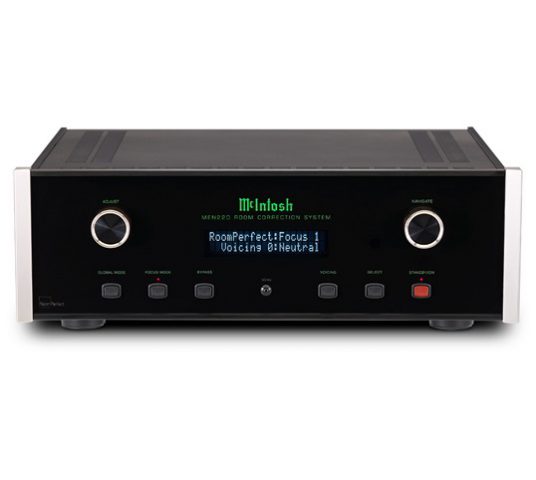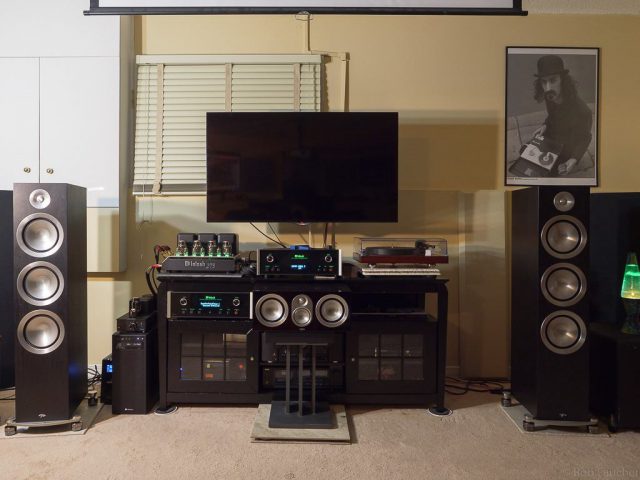Glad to welcome the McIntosh MEN220 in my stereo system. What follows is a review based on a week of continuous use.

After doing enough online research to make my eyes bleed, I pulled the trigger on a brand new MEN220 room correction system. I am glad I did and it has proven to be the most significant tweak in my stereo system, surpassing benefits from power conditioning, high quality interconnects and thick AC cables, etc.
The MEN220 is a digital room correction solution. It works by creating a computer model of your listening room to create parametric equalization curves, proper channel balance, adjust phasing and it can also function as an electronic crossover for bi-amping or subwoofer integration. McIntosh licensed Lyngdorf/Steinway’s Room Perfect software to perform the room measurements and calculations. In some ways it is similar to other systems such as Audyssey, YPOA, MCCAC, DIRAC, etc., which are typically found on home theatre receivers. Whereas home theatre receivers attempt to balance and correct multi-channel audio for movies and adhere to a predefined curve, the McIntosh unit attempts to preserve the original sound of the signal and your equipment, whilst minimizing the negative effects of a listening room.
The MEN220 will require 7 or more careful measurements using an included microphone and stand. The initial measurement is done from the listening position and other measurements should be taken randomly throughout the room at various heights and angles. Eventually it will build up a “room knowledge” profile which should be over 90% and then you are done. This process takes around 30 minutes. The more measurements one takes, the better the correction profile. This is very different approach than home theatre calibration which typically only measure from the theatre seats.
Prior to getting the MEN220, I could never quite get my listening room sounding right, especially in the bass. I purchased bass traps, acoustical panels, two diffusers, as well as attenuating the subwoofer using a sound pressure meter and pink noise. The treatments all helped, however, I knew the room was always going to affect the sound and I am only willing to install so many panels and traps. Mid-range was also affected by room acoustics and could be somewhat improved by tweaking the treble control on my C47 pre-amp. I used measurements taken by Room EQ Wizard and a calibrated microphone to help identify and treat the problem areas, however, that only gets you so far. The data gleaned from Room EQ Wizard proved empirically there is more than can be done.

Could the MEN220 fix those problems, especially considering the technology is several years old? There are other room correction devices out there, however, the McIntosh looked like the best of lot and Lyngdorf’s RoomPerfect software is regarded as an excellent solution for 2 channel audio. The highly configurable electronic crossover allows for seamless subwoofer integration or bi-amping. This alone is a worthwhile feature and helps justify the price tag.
At first I was reluctant to insert any device that does analog to digital and digital to analog conversion between my McIntosh C47 analog pre-amp and MC275 tube power amplifier. Moreover, I really like the sound of my turntable/cartridge combo and Chord 2Qute DAC. Would the MEN220 clobber their signature sound and introduce its own? I kept an open mind as the MEN220 samples, signal processes and outputs at 24 bit/192 kHz, which in theory should be transparent provided high quality components are used internally. Ultimately my ears would have to be the judge.

I auditioned a room calibrated MEN220 at my dealer, Executive Stereo in Toronto. Their demo room is a square configuration with all kinds of audio gear about as well as many glass framed photos hanging on the walls. If the MEN220 can improve sound in this less than ideal room, it should do the same or better in my home. I reasoned the demo room should tell me a lot about how many acoustical sins the MEN220 can absolve. After less than a ½ hour of listening and testing, I was sold.
When I took delivery of my own MEN220, I did 8 random room measurements and got a very satisfying 100% room knowledge with 41% correction. It is worth mentioning that in addition to the positive benefits of room correction, careful configuration of the MEN220’s electronic crossover with the subwoofer made a significant difference. Bass is now remarkably well focused and the transition between the subwoofer and main speakers is virtually seamless. Kick drums sound like kick drums instead of a somewhat mushed up low sound. There is an improved sense of timing and cohesion with all forms of music. The soundstage is wider and my speakers resolve more detail than before. Instruments that were hitherto veiled now have more presence and detail. When RoomPerfect is disabled, I hear slower, flabbier and boomier bass, a smaller sound stage, slightly squashed and darker mid-range and the subwoofer’s seamless integration falls apart. This thing really works and any concerns I had about digitizing analog signals are offset by the benefits.
As a sanity check, I was curious to see what impact the MEN220 has on affecting the sonic signature of analog inputs to the pre-amp. In order to test this out, I configured the MC275 to accept a pure analog path from the RCA outputs of the C47. The pre-amp’s balanced XLR outputs go to the MEN220 and its output is connected to XLR inputs on the power amp. I placed the MEN220 in bypass mode and toggled between the RCA and XLR inputs on the MC275. Frankly I could not hear any immediate or apparent difference. I tried this with my turntable, my Chord 2Qute DAC and the C47’s own internal DAC, each of these devices retained their characteristic sound signatures and detail. To my middle-aged ears, the MEN220 is completely transparent. Now if I was a much younger man, perhaps I could hear some difference with the uncorrected signals, however, I argue that the benefits of RoomPerfect correction and a well-configured electronic crossover far outweigh the cons. You need lead in your ears not to hear the sonic goodness the MEN220 can bring to your system in a typical room. Think of it this way: you have $100, you give up $5 and get $30 in return.
Well worth it.
https://www.mcintoshlabs.com/products/specialty-products/MEN220


Hi.
Do you think that the 2-Channel Hi-Fi System Sound that has been calibrated by McIntosh MEN220 could then again subsequently be Calibrated by Home Theater System’s Audyssey EQ System?
Thank you!
Ken.